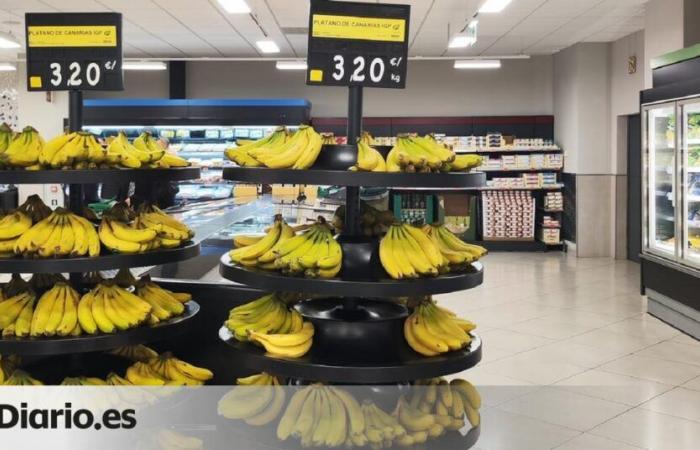
This is the temporal sequence in general terms: 2021, the year of volcanic eruption in La Palma, well in medium prices liquidated to the local harvesting; The following, 2022, excellent; Next, the 2023, very bad, and the precedent to the current one, 2024, bad. This 2025 is only similar to the annual exercise of 2022 because, until now, it is even better than that reference, with markening price liquidations for the fruit sent to the peninsula higher than those of that time, those of the year after the volcanic crisis in La Palma.
This average pricing evolution is accompanied in the 2023-April period of 2025, with some nuances, of course, for another opposite: the years with higher contributions in the destination market of the Canarian fruit are usually the same in which the annual offers are more contained in the islands, below the 420 million kilos a year. It happened in 2021 and in 2022, not in 2023 and neither in 2024. And it is what happens for now, the offer contained, in 2025.
The causes of the current prices behavior, which had as its starting point the beginning of last February, and reaches until today, are above all the shortage of island fruit (with shipments below the seven million per week) and the limitations had been in the same destination market with the competitor of the Canary Islands banana: the banana imported from Central America and Western Africa.
In these weeks of continuous prices by the clouds, both those that the local harvesting and those transferred by the marketer chain will enter until the fruit reaches the final point of sale, only records are recorded. It is enough to see that, after the prices, stop climbing steps on this staircase in weeks 15 and 16 (days in the break, without falls), with the immovable threshold in the 1.48-1.49 euros per kilo that will receive the bannero of the islands, last week (from April 21 to 27, the number 17, and the last with official registers served by the Ministry of Agriculture, Livestock Fish and Food Above, with an increase in the future delivery price to the farmer to 1.54 euros per kilo.
This average value for week 17 (1.54 euros per kilo) is the one that results from subtracting the marketing costs and other minors that the marketing entity loads from the islands (in the fork 0.40-0.50 euros per kilo) and then entering the local producer, before attending its agricultural production costs (those of the farm and with these margins: 0.60-0.70 euros per kilo), which ends Obtaining the market, an average value that, for now, has nothing to do with receiving losses. Yes, for the best categories.
This means that the highest qualities of the Canarian fruit in the peninsula, the extra, the setthey are selling wholesale, green and in the first transaction at average prices of almost two euros per kilo. From then on, everything is to add, and so much that in the shelves of supermarkets and stores of the peninsula the banana of the islands has public sales prices for the qualities reviewed up to four euros per kilo.
It is some crazy or, if preferred, which grants the market due to the shortage of fruit in the islands, with weekly shipping brands below seven million kilos and closer to the six, very little, to which also joins the low competitive offer with origin abroad, the banana which is imported from Central America and Western Africa.
This commercial situation, which, for now, only gives joy to islands with fruit to cut and good qualities and causes complaints and piercing among the final consumers (they must pay on the islands for their banana, that of closeness, more than three euros per kilo, for up to more than four in the peninsula), at the moment it does not offer visos of reaching a break that starts the start or fall.
For now, it seems that it is not when you arrive, with last week, the 17, from April 21 to 27, with a new record in the market price that will be settled to the Canarian farmer: nothing more and nothing less than 1.54 euros per kilo for its fruit with the highest category, the best. This is an increase of 0.05 cents with respect to the anterior average value for that same quality, then, in week 16, at 1.49 euros per kilo.
While the market imposes its law and prices remain alive red, with theoretical profits for the banana trees in the Canary Islands not seen at least since January 1, 2023, since they are well above their agricultural production costs, with yields of more than 0.80 euros per kilo already discounted the payment of the commercialization invoice and before receiving direct help of the banana (of 0.33 euros per kilo if they do not exceed killed 420 million kilos marketed a year), in the institutional and administrative level, in the Asprocan environments and the Canary Islands government, the agendas continue to give milestones.
Thus, on Tuesday, May 6, Martín (from Cupalma), which has renounced re -election in Asprocan, leaves the president in that same employer organization to José Carlos Rendón. This relay will occur on Tuesday in the annual assembly of the entity, with the presence of a single candidate, which is the one proposed by Europlátano and supported by the majority of kilos marketed within the six organizations of bananas producers (OPP) integrated in Asprocan (soon it seems that there will be seven), with the aforementioned Cupalma and Europlátano plus plains of sardine and silver of the Canary Islands.
They are the same that do not support the future territorial decree about to be approved to change the system of distribution of the banana aid within the Posei program, with an annual financial file of the European Union (EU) of 141.1 million euros. Coplaca and Agriten, the other two OPP, support the legal reform promoted since the Parliament of the Canary Islands unanimously and that this Monday will already have, that project of autonomous decree, the opinion of the advisory council, is the last step before the new rule is approved by the Governing Council. This is expected to happen next May 19, Monday, at the Governing Council session.
That regulation, about to be sealing with its publication in the BOC, has the full support of the four professional agricultural organizations: Asaga-Asaja, COAG, UPA and Palca-Union of Unions.





